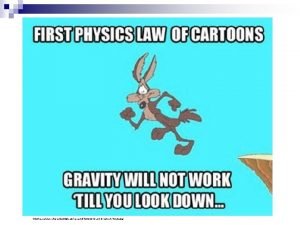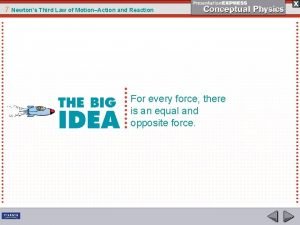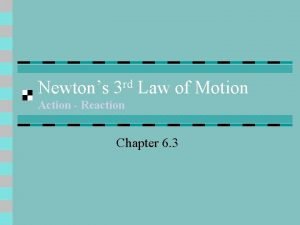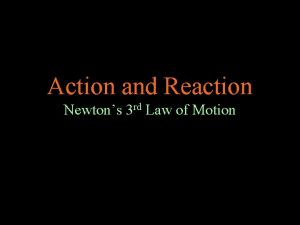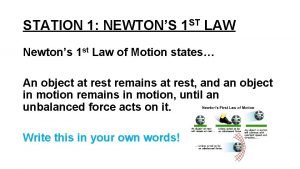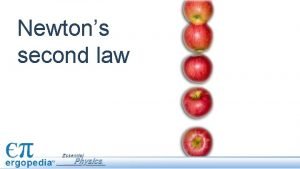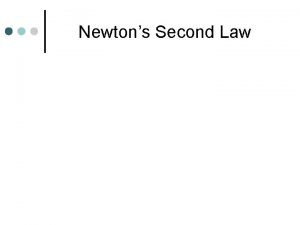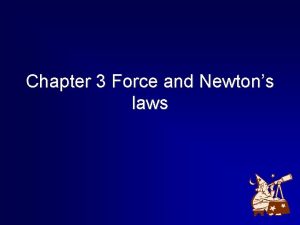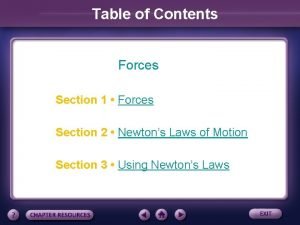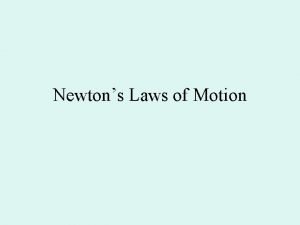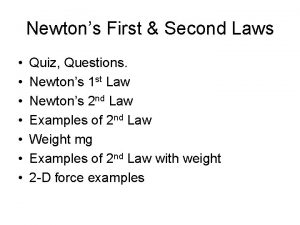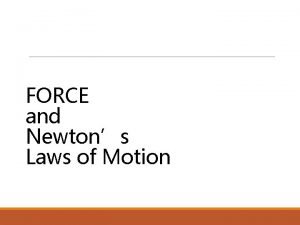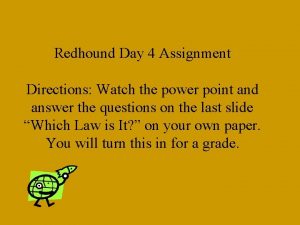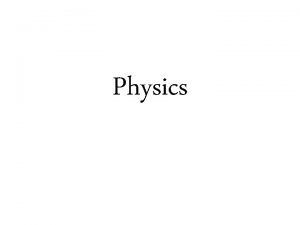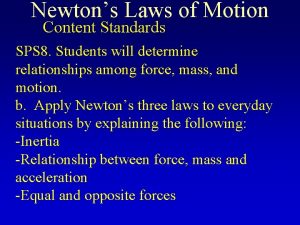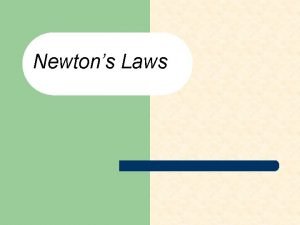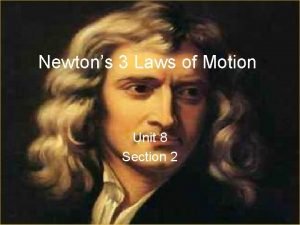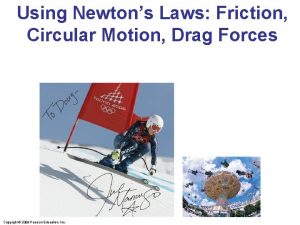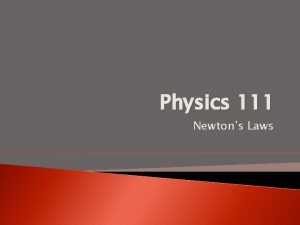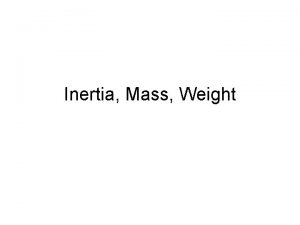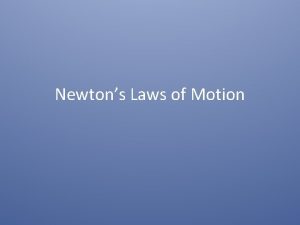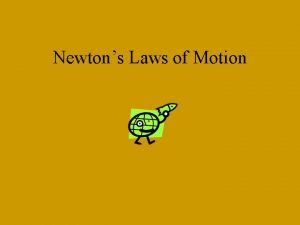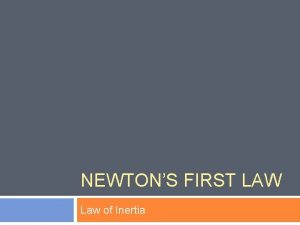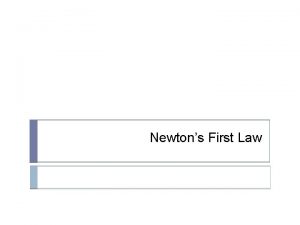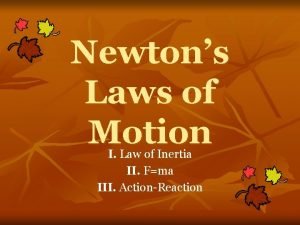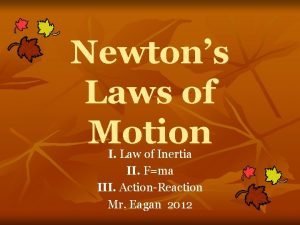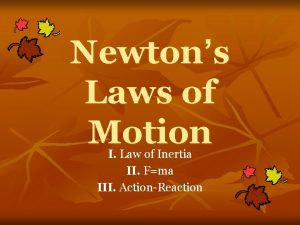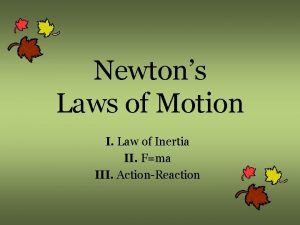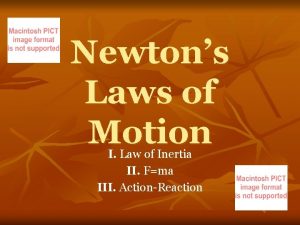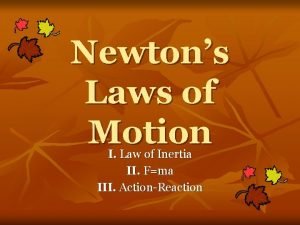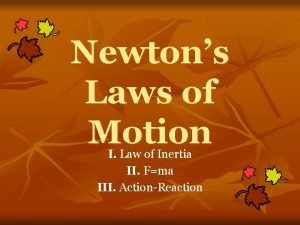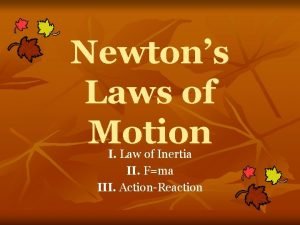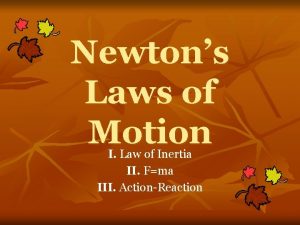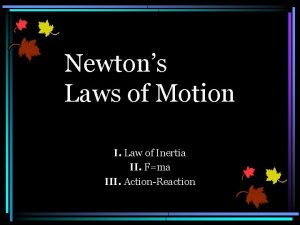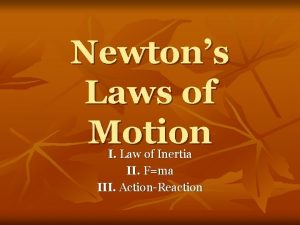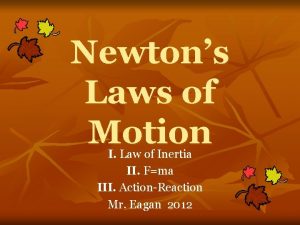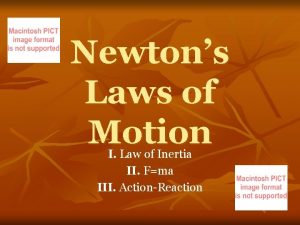Newtons Laws of Motion I Law of Inertia



































- Slides: 35

Newton’s Laws of Motion I. Law of Inertia II. F=ma III. Action-Reaction

Forces and Motion Force- push or pull exerted on an object System- object the force is working on Environment- world around object that the force is working on Contact vs. Long Range Forces Contact forces – force that acts on object only by touching it Long range force- a force exerted w/out contact Force of gravity- long range attractive force that exists between all objects Agent- specific, identifiable, immediate cause of a force Every force must have an agent

Newton’s Laws of Motion 1 st Law – An object at rest will stay at rest, and an object in motion will stay in motion at constant velocity, unless acted upon by an unbalanced force. 2 nd Law – Force equals mass times acceleration. 3 rd Law – For every action there is an equal and opposite reaction.

1 st Law of Motion (Law of Inertia) An object at rest will stay at rest, and an object in motion will stay in motion at constant velocity, unless acted upon by an unbalanced force.

1 st Law Equilibrium – occurs when the net force acting on an object is zero (ex. Rest or constant velocity) Net force- something that disturbs equilibrium Inertia is the tendency of an object to resist changes in its velocity: whether in motion or These pumpkins will not move unless acted on by an unbalanced force. motionless.

1 st Law Once airborne, unless acted on by an unbalanced force (gravity and air – fluid friction), it would never stop!

1 st Law Unless acted upon by an unbalanced force, this golf ball would sit on the tee forever.

Why then, do we observe every day objects in motion slowing down and becoming motionless seemingly without an outside force? It’s a force we sometimes cannot see – friction.

Objects on earth, unlike the frictionless space the moon travels through, are under the influence of friction.

What is this unbalanced force that acts on an object in motion? There are four main types of friction: Sliding friction: ice skating Sliding friction: Rolling friction: bowling Rolling friction: Fluid friction (air or liquid): air or water resistance Fluid friction (air or liquid): Static friction: initial friction when moving an Static friction: object

Slide a book across a table and watch it slide to a rest position. The book comes to a rest because of the presence of a force that force being the force of friction which brings the book to a rest position.

In the absence of a force of friction, the book would continue in motion with the same speed and direction - forever! (Or at least to the end of the table top. )

Newtons’s 1 st Law and You Don’t let this be you. Wear seat belts. Because of inertia, objects (including you) resist changes in their motion. When the car going 80 km/hour is stopped by the brick wall, your body keeps moving at 80 m/hour.

2 nd Law

2 nd Law The net force of an object is equal to the product of its mass and acceleration, or F=ma. A net force acting on an object causes the object to accelerate in the direction of the force Fnet = net sum of vectors (forces) Greater mass>> need greater force to create some acceleration Increased force>> need more mass or greater acceleration to cause change

2 nd Law When mass is in kilograms and acceleration is in m/s/s, the unit of force is in newtons (N). One newton is equal to the force required to accelerate one kilogram of mass at one meter/second. Newton = kg • m/s 2

Common misconceptions of force When a ball has been thrown, the force of the hand that threw it remains on it A force is needed to keep an object moving Inertia is the tendency of an object to do something (description- not a force) Air does not exert a force If no net force, object will keep in motion Force such as friction that change motion of an object Inertia is a force Once hand breaks contact, force no longer exerted Air exerts a large force, it just happens to be balanced on all sides most of the time Quantity (m • a) is a force

2 nd Law (F = m x a) How much force is needed to accelerate a 1400 kilogram car 2 meters per second/per second? Write the formula F = m x a Fill in given numbers and units F = 1400 kg x 2 meters per second/second Solve for the unknown 2800 kg-meters/second or 2800 N

If mass remains constant, doubling the acceleration, doubles the force. If force remains constant, doubling the mass, halves the acceleration.

Newton’s 2 nd Law proves that different masses accelerate to the earth at the same rate, but with different forces. • We know that objects with different masses accelerate to the ground at the same rate. • However, because of the 2 nd Law we know that they don’t hit the ground with the same force. F = ma 98 N = 10 kg x 9. 8 m/s/s 9. 8 N = 1 kg x 9. 8 m/s/s


Check Your Understanding 1. What acceleration will result when a 12 N net force applied to a 3 kg object? A 6 kg object? 2. A net force of 16 N causes a mass to accelerate at a rate of 5 m/s 2. Determine the mass. 3. How much force is needed to accelerate a 66 kg skier 1 m/sec? 4. What is the force on a 1000 kg elevator that is falling freely at 9. 8 m/sec?

Check Your Understanding 1. What acceleration will result when a 12 N net force applied to a 3 kg object? 12 N = 3 kg x 4 m/s/s 2. A net force of 16 N causes a mass to accelerate at a rate of 5 m/s 2. Determine the mass. 16 N = 3. 2 kg x 5 m/s/s 3. How much force is needed to accelerate a 66 kg skier 1 m/sec? 66 kg-m/sec or 66 N 4. What is the force on a 1000 kg elevator that is falling freely at 9. 8 m/sec? 9800 kg-m/sec or 9800 N


3 rd Law For every action, there is an equal and opposite reaction.

3 rd Law According to Newton, whenever objects A and B interact with each other, they exert forces upon each other. When you sit in your chair, your body exerts a downward force on the chair and the chair exerts an upward force on your body.

3 rd Law There are two forces resulting from this interaction - a force on the chair and a force on your body. These two forces are called action and reaction forces.

Newton’s 3 rd Law in Nature Consider the propulsion of a fish through the water. A fish uses its fins to push water backwards. In turn, the water reacts by pushing the fish forwards, propelling the fish through the water. The size of the force on the water equals the size of the force on the fish; the direction of the force on the water (backwards) is opposite the direction of the force on the fish (forwards).

3 rd Law Flying gracefully through the air, birds depend on Newton’s third law of motion. As the birds push down on the air with their wings, the air pushes their wings up and gives them lift.

Consider the flying motion of birds. A bird flies by use of its wings. The wings of a bird push air downwards. In turn, the air reacts by pushing the bird upwards. The size of the force on the air equals the size of the force on the bird; the direction of the force on the air (downwards) is opposite the direction of the force on the bird (upwards). Action-reaction force pairs make it possible for birds to fly.


Other examples of Newton’s Third Law The baseball forces the bat to the left (an action); the bat forces the ball to the right (the reaction).

3 rd Law Consider the motion of a car on the way to school. A car is equipped with wheels which spin backwards. As the wheels spin backwards, they grip the road and push the road backwards.

3 rd Law The reaction of a rocket is an application of the third law of motion. Various fuels are burned in the engine, producing hot gases. The hot gases push against the inside tube of the rocket and escape out the bottom of the tube. As the gases move downward, the rocket moves in the opposite direction.

Second Law vs. Third Law Are these laws contradictory? 2 nd – concerned w/ forces acting on a particular object 3 rd – all forces have an equal and opposite to it Ex. As I push on a book- I am applying a force to the book; the book is pushing back on my hand- (equal & opposite forces are acting on different objects) -may still have a total net force acting on the book
 Newtons laws od motion
Newtons laws od motion 3 newton's laws
3 newton's laws Newton's 3 laws
Newton's 3 laws Three laws of motion
Three laws of motion Newtons 3 rd law of motion
Newtons 3 rd law of motion Newtons 3 rd law of motion
Newtons 3 rd law of motion Third law of motion
Third law of motion Rd law
Rd law Newtons first law of motion meme
Newtons first law of motion meme Newtons third law
Newtons third law Newtons third law of motion
Newtons third law of motion Newtons 3 rd law of motion
Newtons 3 rd law of motion Newtons 3 rd law example
Newtons 3 rd law example Newtons 3 rd law of motion
Newtons 3 rd law of motion Newtons first law
Newtons first law Newtons second.law
Newtons second.law Newton's second law of motion example
Newton's second law of motion example Brainpop newton's laws of motion worksheet answer key
Brainpop newton's laws of motion worksheet answer key Newton's laws
Newton's laws Gravitational field strength equation
Gravitational field strength equation Newtons laws of gravity
Newtons laws of gravity Section 3 using newton's laws
Section 3 using newton's laws Section 1 forces
Section 1 forces Section 3 using newtons laws
Section 3 using newtons laws Newton's st law
Newton's st law Newtons 3 laws quiz
Newtons 3 laws quiz Newtons laws definitions
Newtons laws definitions What are newton's three laws
What are newton's three laws What is newtons law
What is newtons law Newton's third law
Newton's third law Example of law of inertia
Example of law of inertia Second law of motion examples
Second law of motion examples What are the laws of newton
What are the laws of newton Newton's laws of motion
Newton's laws of motion Newton's second law of circular motion
Newton's second law of circular motion Newtons laws
Newtons laws








